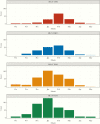Coronavirus Occurrence and Transmission Over 8 Years in the HIVE Cohort of Households in Michigan
- PMID: 32246136
- PMCID: PMC7184402
- DOI: 10.1093/infdis/jiaa161
Coronavirus Occurrence and Transmission Over 8 Years in the HIVE Cohort of Households in Michigan
Abstract
Background: As part of the Household Influenza Vaccine Evaluation (HIVE) study, acute respiratory infections (ARI) have been identified in children and adults from 2010 to 2018.
Methods: Annually, 890 to 1441 individuals were followed and contacted weekly to report ARIs. Specimens collected during illness were tested for human coronaviruses (HCoV) types OC43, 229E, HKU1, and NL63.
Results: In total, 993 HCoV infections were identified during the 8 years, with OC43 most commonly seen and 229E the least. HCoVs were detected in a limited time period, between December and April/May and peaked in January/February. Highest infection frequency was in children <5 years (18 per 100 person-years), with little variation in older age groups (range, 7 to 11 per 100 person-years). Overall, 9% of adult cases and 20% of cases in children were associated with medical consultation. Of the 993 infections, 260 were acquired from an infected household contact. The serial interval between index and household-acquired cases ranged from 3.2 to 3.6 days and the secondary infection risk ranged from 7.2% to 12.6% by type.
Conclusions: Coronaviruses are sharply seasonal. They appear, based on serial interval and secondary infection risk, to have similar transmission potential to influenza A(H3N2) in the same population.
Keywords: coronaviruses; epidemiology; respiratory illness; seasonality; transmission.
© The Author(s) 2020. Published by Oxford University Press for the Infectious Diseases Society of America. All rights reserved. For permissions, e-mail: journals.permissions@oup.com.
Figures



Comment in
-
Estimating Global Epidemiology of Low-Pathogenic Human Coronaviruses in Relation to the COVID-19 Context.J Infect Dis. 2020 Jul 23;222(4):695-696. doi: 10.1093/infdis/jiaa321. J Infect Dis. 2020. PMID: 32497175 Free PMC article. No abstract available.
-
Low Incidence of Reinfection With Endemic Coronaviruses Diagnosed by Real-Time PCR.J Infect Dis. 2021 Jun 4;223(11):2013-2014. doi: 10.1093/infdis/jiaa627. J Infect Dis. 2021. PMID: 33037878 Free PMC article. No abstract available.
-
Factoring in Coronavirus Disease 2019 Seasonality: Experiences From Germany.J Infect Dis. 2021 Sep 17;224(6):1096. doi: 10.1093/infdis/jiab232. J Infect Dis. 2021. PMID: 34009368 Free PMC article. No abstract available.
References
-
- Hamre D, Procknow JJ. A new virus isolated from the human respiratory tract. Proc Soc Exp Biol Med 1966; 121:190–3. - PubMed
MeSH terms
Grants and funding
LinkOut - more resources
Full Text Sources
Other Literature Sources
Research Materials
Miscellaneous

